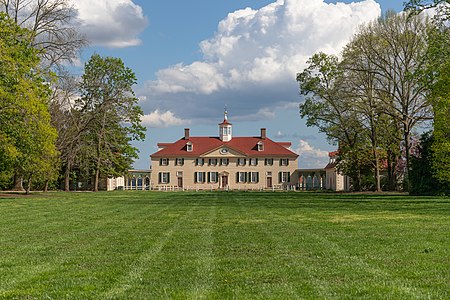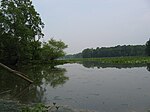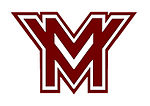Mount Vernon

Mount Vernon is an American landmark and former plantation of Founding Father, commander of the Continental Army in the Revolutionary War, and the first president of the United States George Washington and his wife, Martha. The estate is on the banks of the Potomac River in Fairfax County, Virginia. It is located south of Washington, D.C., and Alexandria, Virginia, and is across the river from Prince George's County, Maryland. The Washington family acquired land in the area in 1674. Around 1734, the family embarked on an expansion of its estate that continued under George Washington, who began leasing the estate in 1754 before becoming its sole owner in 1761.The mansion was built of wood in a loose Palladian style; the original house was built by George Washington's father Augustine, around 1734. George Washington expanded the house twice, once in the late 1750s and again in the 1770s. It remained Washington's home for the rest of his life. Following his death in 1799, under the ownership of several successive generations of the family, the estate progressively declined as revenues were insufficient to maintain it adequately. In 1858, the house's historical importance was recognized and it was taken over by the Mount Vernon Ladies' Association; this organization acquired it together with part of the Washington property estate. The mansion and its surrounding buildings did escape damage from the American Civil War suffered by many properties located within the Confederate States of America. Mount Vernon was designated a National Historic Landmark in 1960 and is listed on the National Register of Historic Places. It is still owned and maintained in trust by the Mount Vernon Ladies' Association, being daily open to the public. Allowing people to see the estate is part of an over 200-year-old tradition started by George Washington. In 1794 he wrote: "I have no objection to any sober or orderly person's gratifying their curiosity in viewing the buildings, Gardens, &ca. about Mount Vernon."
Excerpt from the Wikipedia article Mount Vernon (License: CC BY-SA 3.0, Authors, Images).Mount Vernon
Forest Trail,
Geographical coordinates (GPS) Address Nearby Places Show on map
Geographical coordinates (GPS)
| Latitude | Longitude |
|---|---|
| N 38.708 ° | E -77.0861 ° |
Address
Mount Vernon Mansion
Forest Trail
22121
Virginia, United States
Open on Google Maps










